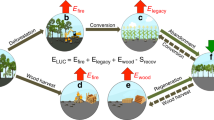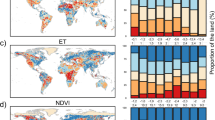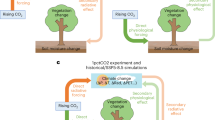Abstract
National and international policy initiatives have focused on reducing carbon emissions as a means by which to limit future climate warming. Much less attention has been paid by policymakers to monitoring, modelling and managing the impacts of climate change on the dynamics of Earth surface systems, including glaciers, rivers, mountains and coasts. This is a critical omission, however, as Earth surface systems provide water and soil resources, sustain ecosystem services and strongly influence biogeochemical climate feedbacks in ways that are as yet uncertain. We argue that there is a significant policy gap regarding the management of Earth surface systems' impacts under climate change that needs to be closed to facilitate the sustainability of cross-national Earth surface resource use. It is also a significant challenge to the scientific community to better understand Earth surface systems' sensitivity to climate forcing.
This is a preview of subscription content, access via your institution
Access options
Subscribe to this journal
Receive 12 print issues and online access
$209.00 per year
only $17.42 per issue
Buy this article
- Purchase on Springer Link
- Instant access to full article PDF
Prices may be subject to local taxes which are calculated during checkout

Similar content being viewed by others
References
IPCC Climate Change 2007: Impacts, Adaptation and Vulnerability (eds Parry, M. L., Canziani, O. F., Palutikof, J. P., van der Linden, P. J. & Hanson, C. E.) (Cambridge Univ. Press, 2007).
New, M., Liverman, D., Schroder, H. & Anderson, K. Four degrees and beyond: The potential for a global temperature increase of four degrees and its implications. Phil. Trans. R. Soc. A 369, 6–19 (2011).
Prinn, R. et al. Scenarios with MIT integrated global systems model: Significant global warming regardless of different approaches. Climatic Change 104, 515–537 (2011).
Bartomeus, I. et al. Climate-associated phenological advances in bee pollinators and bee-pollinated plants. Proc. Natl Acad. Sci. USA 108, 20645–20649 (2011).
Pau, S. et al. Predicting phenology by integrating ecology, evolution and climate science. Glob. Change Biol. 17, 3633–3643 (2011).
Burrows, M. T. et al. The pace of shifting climate in marine and terrestrial ecosystems. Science 334, 652–655 (2011).
Sheldon, K. S., Yang, S. & Tewksbury, J. J. Climate change and community disassembly: Impacts of warming on tropical and temperate montane community structure. Ecol. Lett. 14, 1191–1200 (2011).
Kostyack, J. et al. Beyond reserves and corridors: Policy solutions to facilitate the movement of plants and animals in a changing climate. BioScience 61, 713–719 (2011).
Crossman, N. D., Bryan, B. A. & Summers, D. M. Identifying priority areas for reducing species vulnerability to climate change. Divers. Distrib. 18, 60–72 (2012).
Phillips, J. D. Amplifiers, filters and geomorphic responses to climate change in Kentucky rivers. Climatic Change 103, 571–595 (2010).
Knight, J. & Harrison, S. Evaluating the impacts of global warming on geomorphological systems. Ambio 41, 206–210 (2012).
Murray, A. B. et al. Geomorphology, complexity, and the emerging science of the Earth's surface. Geomorphology 103, 496–505 (2009).
Phillips, J. D. Changes, perturbations, and responses in geomorphic systems. Prog. Phys. Geog. 33, 17–30 (2009).
Temme, A. J. A. M. & Veldkamp, A. Multi-process Late Quaternary landscape evolution modelling reveals lags in climate response over small spatial scales. Earth Surf. Proc. Land. 34, 573–589 (2009).
Marchi, L. & D'Agostino, V. Estimation of debris-flow magnitude in the eastern Italian Alps. Earth Surf. Proc. Land. 29, 207–220 (2004).
Crozier, M. J. Prediction of rainfall-triggered landslides: A test of the antecedent water status model. Earth Surf. Proc. Land. 24, 825–833 (1999).
Brardinoni, F., Hassan, M. A., Rollerson, T. & Maynard, D. Colluvial sediment dynamics in mountain drainage basins. Earth Planet. Sci. Lett. 284, 310–319 (2009).
Dikau, R. & Schrott, L. The temporal stability and activity of landslides in Europe with respect to climatic change (TESLEC): Main objectives and results. Geomorphology 30, 1–12 (1999).
Street-Perrott, F. A. & Barker, P. A. Biogenic silica: A neglected component of the coupled global continental biogeochemical cycles of carbon and silicon. Earth Surf. Proc. Land. 33, 1436–1457 (2008).
Hirohiko, K., Yasumasa, O. & Naotatsu, S. Relationship between weathering, mountain uplift, and climate during the Cenozoic as deduced from the global carbon-strontium cycle model. Palaeogeogr. Palaeoclimatol. Palaeoecol. 270, 139–149 (2008).
Arndt, S., Regnier, P., Godderis, Y. & Donnadieu, Y. GEOCLIM reloaded (v 1.0): a new coupled earth system model for past climate change. Geosci. Model Devel. 4, 451–481 (2011).
Roelandt, C., Godderis, Y., Bonnet, M. P. & Sondag, F. Coupled modeling of biospheric and chemical weathering processes at the continental scale. Global Biogeochem. Cycles 24, http://dx.doi.org/10.1029/2008GB003420 (2011).
Von Rad. U. et al. Multiple monsoon-controlled breakdown of oxygen-minimum conditions during the past 30 000 years documented in laminate sediments off Pakistan. Palaeogeog. Palaeoclimatol. Palaeoecol. 152, 129–161 (1999).
Hrena, M. T., Chamberlain, C. P., Hilley, G. E., Blisniuk, P. M. & Bookhagen, B. Major ion chemistry of the Yarlung Tsangpo-Brahmaputra River: Chemical weathering, erosion, and CO2 consumption in the southern Tibetan Plateau and eastern syntaxis of the Himalaya. Geochim. Cosmochim. Acta 71, 2907–2935 (2007).
Newton, A., Carruthers, T. J. B. & Icely, J. The coastal syndromes and hotspots on the coast. Estuar. Coast. Shelf Sci. 96, 39–47 (2012).
French, J. Tidal marsh sedimentation and resilience to environmental change: Exploratory modelling of tidal, sea-level and sediment supply forcing in predominantly allochthonous systems. Mar. Geol. 235, 119–136 (2006).
Gislason, S. R. et al. Direct evidence of the feedback between climate and weathering. Earth Planet. Sci. Lett. 277, 213–222 (2009).
Turnbull, L., Wainwright, J., Brazier, R. E. & Bol, R. Biotic and abiotic changes in ecosystem structure over a shrub-encroachment gradient in the southwestern USA. Ecosystems 13, 1239–1255 (2010).
Liggins, F., Betts, R. A. & McGuire, B. Projected future climate changes in the context of geological and geomorphological hazards. Phil. Trans. R. Soc. Lond. A 368, 2347–2367 (2010).
St Clair, S. B. & Lynch, J. P. The opening of Pandora's Box: Climate change impacts on soil fertility and crop nutrition in developing countries. Plant Soil 335, 101–115 (2010).
Murray, A. B., Knaapen, M. A. F., Tal, M. & Kirwan, M. L. Biomorphodynamics: Physical–biological feedbacks that shape landscapes. Water Resour. Res. 44, W11301 (2008).
IPCC Special Report on Managing the Risks of Extreme Events and Disasters to Advance Climate Change Adaptation (eds Field, C. B. et al.) (Cambridge Univ. Press, 2012).
Knutti, R. & Hegerl, G. C. The equilibrium sensitivity of the Earth's temperature to radiation changes. Nature Geosci. 1, 735–743 (2008).
Holden, P. B., Edwards, N. R., Oliver, I. C., Lenton, T. M. & Wilkinson, R. D. A probabilistic calibration of climate sensitivity and terrestrial carbon change in GENIE-1. Clim. Dynam. 35, 785–806 (2010).
Bergengren, J. C., Waliser, D. E. & Yung, Y. L. Ecological sensitivity: A biospheric view of climate change. Climatic Change 107, 433–457 (2011).
Annan, J. D. & Hargreaves, J. C. On the generation and interpretation of probabilistic estimates of climate sensitivity. Climatic Change 104, 423–436 (2011).
Lucarini, V., Fraedrich, K. & Lunkeit, F. Thermodynamics of climate change: Generalized sensitivities. Atmos. Chem. Phys. 10, 9729–9737 (2010).
Roe, G. H. & Armour, K. C. How sensitive is climate sensitivity? Geophys. Res. Lett. 38, L14708 (2011).
Hegerl, G. C. & Russon, T. Using the past to predict the future? Science 334, 1360–1361 (2011).
Schmittner, A. et al. Climate sensitivity estimated from temperature reconstructions of the Last Glacial Maximum. Science 334, 1385–1388 (2011).
Loutre, M-F. & Berger, A. Marine Isotope Stage 11 as an analogue for the present interglacial. Glob. Planet. Change 36, 209–217 (2003).
Haywood, A. M. et al. Are there pre-Quaternary geological analogues for a future greenhouse warming? Phil. Trans. R. Soc. A 369, 933–956 (2011).
Kirk-Davidoff, D. B. On the diagnosis of climate sensitivity using observations of fluctuations. Atmos. Chem. Phys. 9, 813–822 (2009).
Lunt, D. J. et al. Earth system sensitivity inferred from Pliocene modelling and data. Nature Geosci. 3, 60–64 (2010).
Olson, R. et al. A climate sensitivity estimate using Bayesian fusion of instrumental observations and an Earth system model. J. Geophys. Res. 117, D04103 (2012).
Harrison, S. in Periglacial and Paraglacial Processes and Environments (eds Knight, J. & Harrison, S.) 257–265 (Geological Society London, 2009).
Anderson, B. et al. Climate sensitivity of a high-precipitation glacier in New Zealand. J. Glaciol. 56, 114–128 (2010).
Ren, D. et al. The Greenland ice sheet response to transient climate change. J. Clim. 24, 3469–3483 (2011).
Warburton, J. Sediment budgets and rates of sediment transfer across cold environments in Europe: A commentary. Geogr. Ann. A 89, 95–100 (2007).
Brown, A. G. et al. From sedimentary records to sediment budgets: Multiple approaches to catchment sediment flux. Geomorphology 108, 35–47 (2009).
Walling, D. E. & Collins, A. L. The catchment sediment budget as a management tool. Environ. Sci. Policy 11, 136–143 (2008).
Rózsa, P. & Novák, T. Mapping anthropic geomorphological sensitivity on a global scale. Z. Geomorphol. 55 (suppl. 1), 109–117 (2011).
Starek, M. J. et al. Modeling and analysis of landscape evolution using airborne, terrestrial, and laboratory laser scanning. Geosphere 7, 1340–1356 (2011).
Irvine-Fynn, T. D. L., Barrand, N. E., Porter, P. R., Hodson, A. J. & Murray, T. Recent high-Arctic glacial sediment redistribution: A process perspective using airborne LiDAR. Geomorphology 125, 27–39 (2011).
Amoudry, L. O. & Souza, A. J. Deterministic coastal morphological and sediment transport modeling: A review and discussion. Rev. Geophys. 49, RG2002 (2011).
Kabir, M. A., Dutta, D. & Hironaka, S. Process-based distributed modeling approach for analysis of sediment dynamics in a river basin. Hydrol. Earth Syst. Sci. 15, 1307–1321 (2011).
Schumm, S. A. Geomorphic thresholds: The concept and its applications. Trans. I. Brit. Geogr. 4, 485–515 (1979).
Downs, P. W. & Gregory, K. J. in Landscape Sensitivity (eds Thomas, D. S. G. & Allison, R. J.) 15–30 (Wiley, 1993).
Carter, L., Orpin, A. R. & Kuehl, S. A. From mountain source to ocean sink — the passage of sediment across an active margin, Waipaoa Sedimentary System, New Zealand. Mar. Geol. 270, 1–10 (2010).
Macklin, M. G. & Lewin, J. Alluvial responses to the changing Earth system. Earth Surf. Proc. Land. 33, 1374–1395 (2008).
Cowie, P. A. et al. New constraints on sediment-flux-dependent river incision: Implications for extracting tectonic signals from river profiles. Geology 36, 535–538 (2008).
Brooks, A. P. & Brierley, G. J. Geomorphic responses of lower Bega River to catchment disturbance, 1851–1926 Geomorphology 18, 291–304 (1997).
Hughes, A. O., Croke, J. C., Pietsch, T. J. & Olley, J. M. Changes in the rates of floodplain and in-channel bench accretion in response to catchment disturbance, central Queensland, Australia. Geomorphology 114, 338–347 (2010).
Hoffmann, T. et al. Human impact on fluvial regimes and sediment flux during the Holocene: Review and future research agenda. Glob. Planet. Change 72, 87–98 (2010).
Arnaud-Fassetta, G. & Provansal, M. High frequency variations of water flux and sediment discharge during the Little Ice Age (1586–1725 AD) in the Rhone Delta (Mediterranean France). Relationship to the catchment basin. Hydrobiologia 410, 241–250 (1999).
Grove, A. T. The “Little Ice Age” and its geomorphological consequences in Mediterranean Europe. Climatic Change 48, 121–136 (2001).
Grove, J. M. & Battagel, A. Tax records from western Norway, as an index of Little Ice Age environmental and economic deterioration. Climatic Change 5, 265–282 (1983).
Parry, M. et al. Millions at risk: Defining critical climate change threats and targets. Glob. Environ. Change 11, 181–183 (2001).
Perch-Nielsen, S-L., Bättig, M. B. & Imboden, D. Exploring the link between climate change and migration. Climatic Change 91, 375–393 (2008).
Hooke, R. LeB. On the history of humans as geomorphic agents. Geology 28, 843–846 (2000).
Wilkinson, B. H. & McElroy, B. J. The impact of humans on continental erosion and sedimentation. Geol. Soc. Am. Bull. 119, 140–156 (2007).
Syvitski, J. P. M. & Kettner, A. Sediment flux and the Anthropocene. Phil. Trans. R. Soc. A 369, 957–975 (2011).
Thomas, C. D. et al. A framework for assessing threats and benefits to species responding to climate change. Method. Ecol. Evol. 2, 125–142 (2011).
Haeberli, W., Hoelzle, M., Paul, F. & Zemp, M. Integrated monitoring of mountain glaciers as key indicators of global climate change: The European Alps. Ann. Glaciology 46, 150–160 (2007).
Hilker, N., Badoux, A. & Hegg, C. The Swiss flood and landslide damage database 1972–2007 Nat. Hazard. Earth Sys. Sci. 9, 913–925 (2009).
Betts, R. Implications of land ecosystem–atmosphere interactions for strategies for climate change adaptation and mitigation. Tellus B 59, 602–615 (2007).
Malcolm, J. R., Markham, A., Neilson, R. P. & Garaci, M. Estimated migration rates under scenarios of global climate change. J. Biogeogr. 29, 835–850 (2002).
Syvitski, J. The Anthropocene: An epoch of our making. Glob. Change IGBP 78, 12–15 (2012).
Beylich, A. A., Lamoureux, S. F. & Decaulne, A. Developing frameworks for studies on sedimentary fluxes and budgets in changing cold environments. Quaest. Geogr. 30, 5–18 (2011).
Syvitski, J. P. M. & Milliman, J. D. Geology, geography, and human's battle for dominance over the delivery of fluvial sediment to the coastal ocean. J. Geol. 115, 1–19 (2007).
Anderson, K. & Bows, A. Beyond 'dangerous' climate change: Emission scenarios for a new world. Phil. Trans. R. Soc. A 369, 20–44 (2011).
Yan, Y. et al. Closing the carbon budget of estuarine wetlands with tower-based measurements and MODIS time series. Glob. Change Biol. 14, 1690–1702 (2008).
Polson, D. et al. Estimation of spatial apportionment of greenhouse gas emissions for the UK using boundary layer measurements and inverse modelling technique. Atmos. Environ. 45, 1042–1049 (2011).
Lun, F., Li, W. H. & Liu, Y. Complete forest carbon cycle and budget in China, 1999–2008. Forest Ecol. Manag. 264, 81–89 (2012).
Davis, C. M. & Fox, J. F. Sediment fingerprinting: Review of the method and future improvements for allocating nonpoint source pollution. J. Environ. Eng. 135, 490–504 (2009).
Steffen, W. et al. The Anthropocene: From global change to planetary stewardship. Ambio 40, 739–761 (2011).
Woodroffe, C. D. & Murray-Wallace, C. V. Sea-level rise and coastal change: The past as a guide to the future. Quat. Sci. Rev. (in the press).
Hurtt, G. C. et al. Harmonization of land-use scenarios for the period 1500–2100, 600 years of global gridded annual land-use transitions, wood harvest, and resulting secondary lands. Climatic Change 109, 117–161 (2011).
Pauling, A., Luterbacher, J., Casty, C. & Wanner, H. Five hundred years of gridded high-resolution precipitation reconstructions over Europe and the connection to large-scale circulation. Clim. Dynam. 26, 387–405 (2006).
Greenland Summit Ice Cores CD-ROM from the National Snow and Ice Data Center, University of Colorado at Boulder, and the World Data Center-A for Paleoclimatology, National Geophysical Data Center, Boulder, Colorado (1997); available via http://go.nature.com/th48gX
Stoffel, M. et al. Analyzing rockfall activity (1600–2002) in a protection forest — A case study using dendrogeomorphology. Geomorphology 68, 224–241 (2005).
Lamb, H. H. Climatic variation and changes in the wind and ocean circulation: the Little Ice Age in the northeast Atlantic. Quat. Res. 11, 1–20 (1979).
Acknowledgements
We thank B. Murray for comments.
Author information
Authors and Affiliations
Corresponding author
Ethics declarations
Competing interests
The authors declare no competing financial interests.
Rights and permissions
About this article
Cite this article
Knight, J., Harrison, S. The impacts of climate change on terrestrial Earth surface systems. Nature Clim Change 3, 24–29 (2013). https://doi.org/10.1038/nclimate1660
Received:
Accepted:
Published:
Issue Date:
DOI: https://doi.org/10.1038/nclimate1660
This article is cited by
-
Bioclimatic atlas of the terrestrial Arctic
Scientific Data (2023)
-
Iterative integration of deep learning in hybrid Earth surface system modelling
Nature Reviews Earth & Environment (2023)
-
Morphodynamic limits to environmental signal propagation across landscapes and into strata
Nature Communications (2022)
-
Warming-driven erosion and sediment transport in cold regions
Nature Reviews Earth & Environment (2022)
-
Planning for Climate Change Impacts on Geoheritage Interests in Protected and Conserved Areas
Geoheritage (2022)



